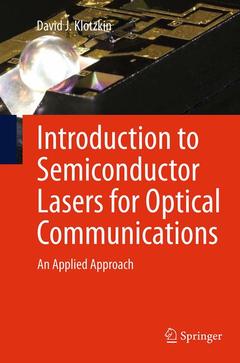Introduction to Semiconductor Lasers for Optical Communications, Softcover reprint of the original 1st ed. 2014 An Applied Approach

This textbook provides a thorough and accessible treatment of semiconductor lasers from a design and engineering perspective. It includes both the physics of devices as well as the engineering, designing and testing of practical lasers. The material is presented clearly with many examples provided. Readers of the book will come to understand the finer aspects of the theory, design, fabrication and test of these devices and have an excellent background for further study of optoelectronics.
This book also:
Provides a multi-faceted approach to explaining the theories behind semiconductor lasers, utilizing mathematical examples, illustrations and written theoretical presentations
Offers a balance of relevant optoelectronic topics, with specific attention given to distributed feedback lasers, growth techniques and waveguide cavity design
Provides a summary of every chapter, worked examples, and problems for readers to solve
Incorporates and explains recent breakthroughs in laser design
Ouvrage de 285 p.
15.5x23.5 cm



